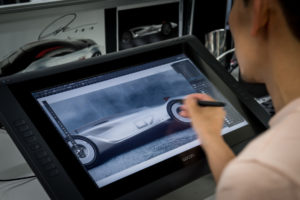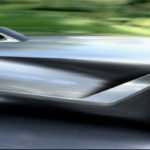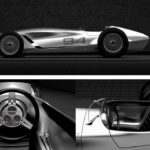At the 2017 Pebble Beach Concours d’Elegance, #Nissan Motor Corporation and premium automotive brand #INFINITI have unveiled #Prototype 9, a sleek, open-wheeled electric retro-roadster prototype. The car is a celebration of Nissan and INFINITI’s ingenuity, artistry and craftsmanship. It represents a reimagining of a 1940s race car with time-honoured production techniques employed to realise its retro design.
 Alfonso Albaisa, Senior Vice President, Global Design: “Prototype 9 celebrates the tradition of ingenuity, craftsmanship and passion of our forebears at Nissan, on whose shoulders we stand today. It started as a discussion – what if INFINITI had created a race car in the 1940s? If one were to imagine an open-wheeled INFINITI racer on the famous circuits of the era, such as Japan’s Tamagawa Speedway, what would that look like? The sketches were stunning and the idea so compelling that we had to produce a prototype. As other departments became aware of this, they volunteered their time to create a working vehicle.”
Alfonso Albaisa, Senior Vice President, Global Design: “Prototype 9 celebrates the tradition of ingenuity, craftsmanship and passion of our forebears at Nissan, on whose shoulders we stand today. It started as a discussion – what if INFINITI had created a race car in the 1940s? If one were to imagine an open-wheeled INFINITI racer on the famous circuits of the era, such as Japan’s Tamagawa Speedway, what would that look like? The sketches were stunning and the idea so compelling that we had to produce a prototype. As other departments became aware of this, they volunteered their time to create a working vehicle.”
Prototype 9 is emblematic of INFINITI’s entrepreneurial spirit and passion for stunning design. From humble beginnings as a sketch, to the dynamic example presented at Pebble Beach, Prototype 9 has been brought to life as an after-hours endeavour by a passionate and enterprising team of employees from across the Nissan Motor Corporation. The car is powered by a prototype electric motor and battery from Nissan’s Advanced Powertrain Department. This nod to the future contrasts with the traditional materials and techniques applied for the Prototype 9’s manufacture, including panels hand-beaten by a team of Takumi – Nissan Motor Corporation’s master craftspeople.
 Prototype 9 was inspired by an emerging era of Japanese motorsport. The custom-built Prince R380, which also makes its public debut at the 2017 Concours d’Elegance, broke several land speed records in 1965 before taking overall victory at the 1966 Japanese Grand Prix at Fuji Speedway. Prince Motor Company is considered to be Japan’s original builder of premium automobiles, and its legacy can be traced to INFINITI Motor Company and its current model line. The R380 in Pebble Beach is the actual Japanese Grand Prix-winning car, believed to be the only surviving R380. Where existing and future INFINITI models adhere to the company’s ‘Q’ and ‘QX’ nomenclature, Prototype 9 represents something different. Echoing the company’s origins, the figure ‘9’ is pronounced ‘kyuu’ in Japanese – similar to the anglicized pronunciation of the letter ‘Q’, which is used for all of the company’s production cars.
Prototype 9 was inspired by an emerging era of Japanese motorsport. The custom-built Prince R380, which also makes its public debut at the 2017 Concours d’Elegance, broke several land speed records in 1965 before taking overall victory at the 1966 Japanese Grand Prix at Fuji Speedway. Prince Motor Company is considered to be Japan’s original builder of premium automobiles, and its legacy can be traced to INFINITI Motor Company and its current model line. The R380 in Pebble Beach is the actual Japanese Grand Prix-winning car, believed to be the only surviving R380. Where existing and future INFINITI models adhere to the company’s ‘Q’ and ‘QX’ nomenclature, Prototype 9 represents something different. Echoing the company’s origins, the figure ‘9’ is pronounced ‘kyuu’ in Japanese – similar to the anglicized pronunciation of the letter ‘Q’, which is used for all of the company’s production cars.
 The starting point for bringing Prototype 9 to life was a conceptual sketch: an interpretation of an INFINITI race car, inspired by roadsters and aircraft of the era yet moulded in new materials and advanced technology. From this moment Prototype 9’s transformation from sketch to reality was inevitable. Albaisa created a sketch of the vehicle, with sleek lines, and aeronautically-inspired bodywork crafted in bare sheet metal. Initially shared only with close colleagues, the idea soon spread among INFINITI’s design team members – with a number enthusiastically calling for the vehicle to be brought to life. The sketch triggered a domino effect – each person who saw it felt it deserved more attention, and soon there was a burgeoning desire to take it beyond the drawing board.
The starting point for bringing Prototype 9 to life was a conceptual sketch: an interpretation of an INFINITI race car, inspired by roadsters and aircraft of the era yet moulded in new materials and advanced technology. From this moment Prototype 9’s transformation from sketch to reality was inevitable. Albaisa created a sketch of the vehicle, with sleek lines, and aeronautically-inspired bodywork crafted in bare sheet metal. Initially shared only with close colleagues, the idea soon spread among INFINITI’s design team members – with a number enthusiastically calling for the vehicle to be brought to life. The sketch triggered a domino effect – each person who saw it felt it deserved more attention, and soon there was a burgeoning desire to take it beyond the drawing board.
More designers at the INFINITI Design Studio in Atsugi, Japan, began making their own detail contributions – the shape, design and materials that could feature in the cockpit, for example. Chasing a passion for beautiful vehicle design, the team moved to bring the sketch into the physical world. The vehicle was transformed from a daring idea into scale design studies in clay. Full-size models were soon formed. Although still a secretive ‘passion project’ at this point, word seeped into other parts of INFINITI Motor Company and throughout its parent company, the Nissan Motor Corporation. People noticed something a little different was taking shape at the design centre.
Redazione MotoriNoLimits


















